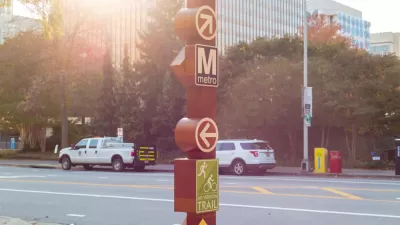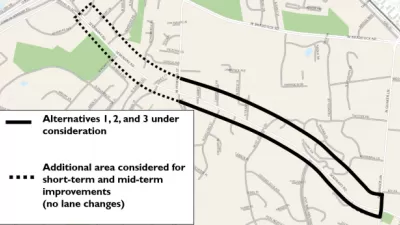When it comes to intersections, adding more complexity can do more harm than good, according to a recent, detailed post on Greater Greater Washington.
Ben Ross decries the growing complexity of traffic signals at intersections all over the country, which might be better at distracting drivers than they are at directing them.
Ross selects the "intersection of doom" in Arlington—where Mount Vernon Trail turns into Custis Trail at the foot of the Key Bridge in Arlington—as a case study of unnecessary complexity in traffic signals and intersection design. There, explains Ross, "Drivers must simultaneously watch for cars coming from the left, cyclists and pedestrians entering the crosswalk from the right, and an overhead signal that went in in January that flashes a no-right-turn graphic for a few seconds during the leading pedestrian interval." Moreover, "the no-right-turn graphic is hard to see in bright light, and it is flanked by highly visible signs that seem to say turns are allowed."
According to Ross the arrangement of this intersection is common around American cities—the only thing remarkable about it is the large number of bikes and pedestrians travelling through the intersection.
The article goes on to discuss larger concepts that inform an understanding of how intersections like this fail to meet a goal of reliably keeping roads safe. Ross notes especially that two concepts are missing from traffic engineering guidelines: redundancy and parsimony. "Redundancy means backups for missed signals and improper actions. Parsimony means signals aren't excessively complex."
FULL STORY: Complex traffic signals make streets less safe

Planetizen Federal Action Tracker
A weekly monitor of how Trump’s orders and actions are impacting planners and planning in America.

San Francisco's School District Spent $105M To Build Affordable Housing for Teachers — And That's Just the Beginning
SFUSD joins a growing list of school districts using their land holdings to address housing affordability challenges faced by their own employees.

The Tiny, Adorable $7,000 Car Turning Japan Onto EVs
The single seat Mibot charges from a regular plug as quickly as an iPad, and is about half the price of an average EV.

With Protected Lanes, 460% More People Commute by Bike
For those needing more ammo, more data proving what we already knew is here.

In More Metros Than You’d Think, Suburbs are Now More Expensive Than the City
If you're moving to the burbs to save on square footage, data shows you should think again.

The States Losing Rural Delivery Rooms at an Alarming Pace
In some states, as few as 9% of rural hospitals still deliver babies. As a result, rising pre-term births, no adequate pre-term care and "harrowing" close calls are a growing reality.
Urban Design for Planners 1: Software Tools
This six-course series explores essential urban design concepts using open source software and equips planners with the tools they need to participate fully in the urban design process.
Planning for Universal Design
Learn the tools for implementing Universal Design in planning regulations.
Smith Gee Studio
City of Charlotte
City of Camden Redevelopment Agency
City of Astoria
Transportation Research & Education Center (TREC) at Portland State University
US High Speed Rail Association
City of Camden Redevelopment Agency
Municipality of Princeton (NJ)





























